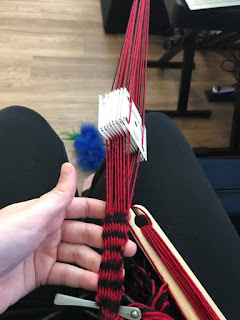I recently started using silk to make garment trim. This is probably what people would have preferred I started with, but I wanted to work with a material that was a little easier and wool is nice and forgiving to start weaving with! Silk is very fiddly to work with, but the finished products look so pretty! I also was told that it was the next easiest fiber to work with, so that factored into my choice to start working with it too! I hear linen is extremely unforgiving so I'm putting that off for right now.
I asked the forums I'm in for what silk yarn/thread was the best for tablet weaving garment trim and received several responses, but I eventually chose a 30/2 weight silk made close by in British Columbia. Here's the link for those interested:
https://janestaffordtextiles.com/product-category/yarns/silk/handdyed-30-2-bombyx-silk/
 |
| Here's the silk colors I ordered - red, black, grey, ivory, sage green, light blue, golden yellow - I had them spooled because I can't even imagine this weight as a skein. I'd have made a total tangled mess of it. |
Working with this weight of silk is pretty much like weaving with sewing thread - it is extremely fine and a little maddening at first. I guess I'm getting old because I can barely see what I'm doing when I'm stringing my loom!
I made the mistake of starting with a more difficult pattern and, because I wasn't used to working with the material, messed it up horrifically and almost scrapped the entire project before being talked out of it. I was able to switch to a different, easier pattern and finished it out - which is good because I ended up with a lot of usable trim that I'm going to gift to a friend.
 |
| I was doing a different pattern before I messed it up and switched to this one. It looks much nicer like this. |
 |
| The finished product is really nice, you'd never know I cut off 4 inches of terribleness. |
Since my initial mess up, I also made some trim for David to go on a tunic, and I have quite a few more projects lined up, which is good because the silk comes in spools of
1650 yards... so I'm sure I'll have enough for a little bit.
 |
| This is a really simple pattern, but the black and white makes it really fancy looking! |
 |
| David is checking it out - he seems to really like it! |
 |
| You can see how thin and delicate the silk is - it rolls up so neatly! |






































